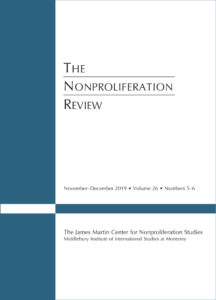March 26, 2020
The latest issue of the Nonproliferation Review (NPR) is now available to subscribers.

The centerpiece of this double issue is a substantial special section on the shifting South Asian nuclear landscape. The NPR last presented a special section on this subject in 2014 (Vol. 21, Nos. 3–4), and the changes over the last five years, while gradual, show a steady movement in a single direction: more weapons, more delivery systems, and more tensions. Judging by the 2017 border confrontation between India and China and the violent exchanges between Pakistan and India in 2019, which included the first cross-border use of air power since 1971, the continued development of nuclear arsenals in the region seems unlikely to foster greater stability. Frank O’Donnell, Susan Turner Hayes, Diana Wueger, Rajeswari Pillai Rajagopalan, and Yogesh Joshi have contributed articles to this special section, which is introduced by guest editor—and NPR editorial board member—Sumit Ganguly.
Separately, this issue features two contributions on Northeast Asia, where the prospects for North Korea’s nuclear disarmament appear more distant than ever. Working with Chinese publications and interviews conducted in China, Covell Meyskens dissects Chinese attitudes toward North Korea and its nuclear program. William Moon, responding to proposals for a version of the Cooperative Threat Reduction program to be established in North Korea, discusses how such an effort might be launched without having a comprehensive agreement on disarmament in place.
Beyond the world’s worst proliferation trouble spots, the International Atomic Energy Agency is primarily responsible for nuclear safeguards, which provide assurances that a country’s nuclear materials are employed in peaceful uses. Ian J. Stewart and Noah Mayhew describe the Agency’s dilemma of supporting an expanding safeguards burden with a relatively static budget. They examine three possible responses: expanding the budget, finding efficiencies in safeguards practices, and adopting new technologies.
So far, South Africa is the sole country to dismantle all of its nuclear weapons and accede to the 1968 Treaty on the Non-Proliferation of Nuclear Weapons (NPT). Robin Möser presents a new account of its decision to accede that shows it to have been fundamentally separate from disarmament itself, and far more challenging to achieve in the maze of domestic politics in the last years of apartheid. Through interviews with former officials and previously untapped primary sources, Möser describes how the F.W. de Klerk government overcame these obstacles by enlisting the world’s major powers in a campaign of encouraging NPT accessions across the southern African region. The success of this strategy laid the groundwork for the establishment of the African Nuclear-Weapon-Free Zone.
Emmanuelle Maitre and Pauline Lévy analyze Austria’s rise to leadership in the diplomacy of disarmament, including a crucial role leading up to the negotiation of the 2017 Treaty on the Prohibition of Nuclear Weapons (TPNW). Their study emphasizes Austria’s particular confluence of Cold War neutrality, broadly based antinuclear sentiment, and commitment to humanitarian principles. This combination of factors allowed a core group of highly motivated Austrian diplomats with experience in the conventional disarmament sphere to build support within the government for a new activism on nuclear disarmament.
In the realm of chemical weapons, Stefano Costanzi and Gregory D. Koblentz examine two proposals submitted to the Organisation for the Prohibition of Chemical Weapons (OPCW) to add so-called Novichok nerve agents to the 1993 Chemical Weapons Convention’s list of banned chemicals. Their recommendation—that OPCW member states adopt both a modified Russian proposal and a proposal from the United States, Canada, and the Netherlands—was agreed upon at the OPCW conference in November 2019.
In a separate article, Gregory D. Koblentz considers the next phase of investigations into the uses of chemical weapons in Syria: moving from identifying their use to attributing them to specific actors. Koblentz reviews what is known about the nine attacks to be investigated by the OPCW’s newly formed Investigation and Identification Team, and calls for moving beyond attribution to accountability for the perpetrators.
In Correspondence, David M. Allison and Stephen Herzog provide a thoughtful critique of “Gas, power, and norms: competing logics for the declining use of chemical warfare,” by Damir Kovačević, Afrimadona, and Martin Claar (Vol. 29, No. 3–4). Emphasizing the limited utility of chemical weapons on the traditional battlefield, Allison and Herzog propose a sharp delineation between their uses in interstate wars, which have become scarce, and their uses in civil wars, which occur more often.
This issue contains three book reviews. Andrew Futter reviews Cross-Domain Deterrence: Strategy in an Era of Complexity, edited by Erik Gartzke and Jon R. Lindsay. James Wirtz reviews China and Global Nuclear Order, by Nicola Horsburgh (Leveringhaus). Martin Pfeiffer reviews Armageddon Insurance: Civil Defense in the United States and Soviet Union, 1945–1991, by Edward Geist.
Finally, Director of the James Martin Center for Nonproliferation Studies William Potter offers a fond remembrance of his friend and colleague Ambassador Roland Timerbaev, who passed away in August 2019.
— Joshua H. Pollack, Editor
Rhianna Tyson Kreger, Managing Editor
The NPR is the world’s only peer-reviewed journal concerned with the causes, consequences, and control of the spread of nuclear, chemical, and biological weapons. It features case studies, theoretical analyses, historical studies, reports, viewpoints, and book reviews on such issues as state-run weapons programs, treaties and export controls, safeguards, verification and compliance, disarmament, terrorism, and the economic and environmental effects of weapons proliferation.
For more information on how to subscribe, contact [email protected].
